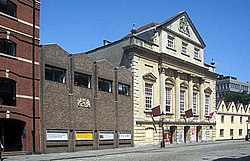Bristol Old Vic

The Coopers' Hall (right), which became the theatre foyer in the 1970s
|
|
| Address | King Street BS1 4ED Bristol United Kingdom |
|---|---|
| Coordinates | 51°27′07″N 2°35′38″W / 51.452°N 2.594°W |
| Owner | Trustees of the Theatre Royal |
| Designation | Grade I listed building |
| Type | Repertory |
| Capacity | 540 (Theatre Royal) 150 (Studio) |
| Construction | |
| Opened | 1766 |
| Rebuilt | 1970–72 |
| Website | |
| Bristol Old Vic | |
Bristol Old Vic is a British theatre company based at the Theatre Royal, Bristol. The present company was established in 1946 as an offshoot of the Old Vic in London. It is associated with the Bristol Old Vic Theatre School, which became a financially independent organisation in the 1990s. Bristol Old Vic runs a popular, and highly successful Young Company for young people aged 7–25.
The Theatre Royal, the oldest continually-operating theatre in the English speaking world, was built during 1764–66 on King Street in Bristol. The Coopers' Hall, built 1743–44, was incorporated as the theatre's foyer during 1970–72. Together, they are designated a Grade I listed building by Historic England.Daniel Day-Lewis called it "the most beautiful theatre in England."
In 2012 the theatre complex completed the first phase of a £19 million refurbishment, increasing seating capacity and providing up to ten flexible performance spaces. Besides the main Theatre Royal auditorium, the complex includes the Studio theatre and the Side Stage, Paint Shop and Basement performance areas. Whilst the theatre was closed, the company continued to present work in the Studio and Basement spaces, as well as at other sites around Bristol. The Theatre Royal re-opened in 2012 with Wild Oats.
The theatre is situated on King Street, a few yards from the Floating Harbour. Since 1972, the public entrance has been through the Coopers' Hall, the earliest surviving building on the site. The Coopers' Hall was built in 1744 for the Coopers' Company, the guild of coopers in Bristol, by architect William Halfpenny. It has a "debased Palladian" façade with four Corinthian columns. It only remained in the hands of the Coopers until 1785, subsequently becoming a public assembly room, a wine warehouse, a Baptist chapel and eventually a fruit and vegetable warehouse.
...
Wikipedia
